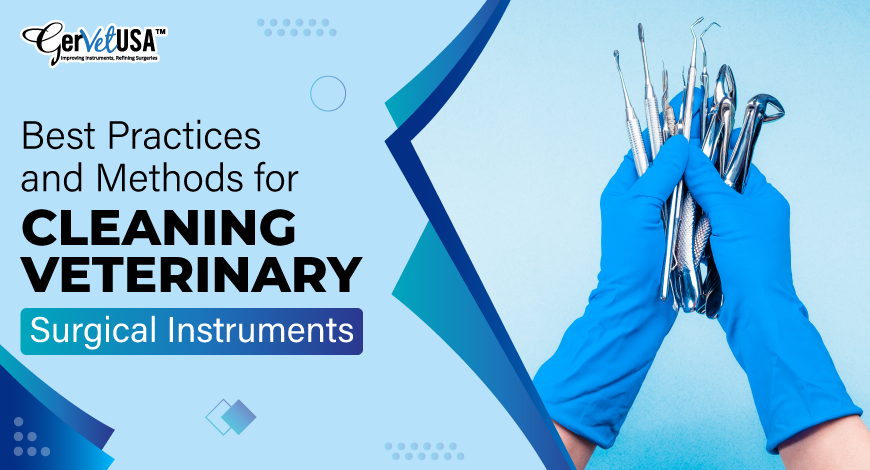Surgical instruments are crucial for saving animals' lives, but what happens if they're not cleaned properly? Well, that's a nightmare no veterinary professional wants to deal with! Cleaning veterinary surgical instruments is more than just a matter of appearance. It's about safety, precision, and maintaining quality care.
Sterilizing surgical instruments is not rocket science. So, let's discuss the essential practices and methods for sterilizing and cleaning surgical instruments veterinary. By understanding the basic steps and avoiding common mistakes, you can ensure that the tools are always ready for action.
Keep reading!
The Importance of Cleaning Veterinary Surgical Instruments
Keeping Pet Patients Safe
First and foremost, clean instruments are synonymous with healthy pet patients. Here's why:
• Infection Prevention: By ridding tools of harmful bacteria, you're stopping infections before they start.
• Functionality: Properly cleaned instruments work as they're supposed to, allowing for successful surgeries and medical procedures.
Maintaining Professional Standards
• Compliance with Veterinary Sterilization Protocol: Sterilizing instruments is not just good practice; it's the law. Stick to guidelines to stay on the right side of regulations.
• Boosting Reputation: Showing you care about cleanliness helps build trust with patients and other medical professionals.
Risks of Not Cleaning Surgery Equipment Properly
Contaminated instruments can cause so many problems, and the stakes are high. Here's what could go wrong:
Spread of Infections
• Pet Patient Risk: Improperly cleaned instruments can carry bacteria, leading to infections. It's not worth playing fast and loose with someone's health.
• Staff Exposure: Health professionals may also be infected if tools aren't sterilized properly.
Decreased Instrument Longevity
• Wear and Tear: Failing to clean instruments properly can cause them to deteriorate faster. Before you know it, you'll face unexpected expenses to replace them.
• Malfunction During Procedures: This is more than an inconvenience. A malfunctioning instrument can be a matter of life and death during a surgical procedure.
Surgical Instrument Cleaning Steps Veterinary
1. Pre-cleaning: Rinse the instruments immediately to remove visible dirt and debris.
2. Washing: Either manually wash your instruments or use an automatic washer. Your choice should depend on the instruments and the manufacturer's recommendations.
3. Disinfecting: This step is crucial. It involves killing harmful bacteria and making sure your instruments are safe.
4. Rinsing Again: Remove all cleaning solutions and disinfectants to avoid leaving a residue.
5. Drying: A simple step, yet vital. Moisture can breed bacteria, so make sure those instruments are bone-dry.
6. Inspection and Maintenance: Keep a keen eye out for damage and ensure everything works smoothly.
Following these surgical instrument cleaning steps is crucial for ensuring patient safety.
5 Best Practices for Cleaning Veterinary Surgical Instruments
In the medical field, cleaning veterinary surgical instruments is mandatory. It is something that no surgeon wants to mess up. So, let's cut to the chase and discuss the 5 best practices for cleaning all contaminated tools.
1. Follow Manufacturer Guidelines
Every instrument has a particular way it likes to be cleaned. And who knows better than the folks who made it?
• Read the Manual: It has all the details on cleaning that particular instrument.
• Use Recommended Products: Stick to the cleaning solutions and tools the manufacturer vouches for.
2. Pre-Clean Immediately After Use
Time's ticking once you're done using a surgical instrument.
• Rinse It Off: Rinse off any visible debris immediately after use. It's like washing dishes – easier when it's fresh.
• Soak if Needed: Some tools may need a nice soak to remove stubborn bits.
3. Automate When You Can
Let's face it; machines are often better at cleaning veterinary surgical instruments veterinary.
• Utilize Ultrasonic Cleaners: These nifty devices can get into nooks and crannies that hands can't reach.
• Employ Washer-Disinfectors: These machines can be a godsend for that extra layer of cleanliness.
4. Regular Inspection and Maintenance
An instrument that looks clean might not be. You have to make sure it is inspected and maintained regularly.
• Inspect Regularly: Check for wear and tear, discolorations, and other signs of something amiss.
• Maintain Properly: Regular maintenance ensures that everything's working as it should.
5. Train and Retrain Staff
Keeping surgical instruments clean is a team effort.
• Provide Proper Training: Make sure everyone knows the procedures like the back of their hand.
• Offer Refresher Courses: Even old hands can benefit from a refresher now and then.
Recommended Methods for Cleaning Veterinary Surgical Instruments
Cleaning surgery equipment is not as simple as washing the dishes after dinner! When it comes to these life-saving tools, proper methods, precision, and care are critical. So, let's break down the recommended process of cleaning surgical instruments,
1. Manual Cleaning
Cleaning veterinary surgical instruments manually is ideal when the tools have complex structures and machine cleaning is not feasible.
• When to Use: When instruments are delicate or have intricate parts.
How to Do It:
• Wear Protective Gear: Safety first! Gloves and eye protection are a must.
• Rinse: Start with a good rinse to wash away visible debris.
• Scrub: Use soft brushes and manufacturer-recommended detergents.
• Rinse Again: Rinse thoroughly to remove all cleaning agents.
• Dry: Air dry or use clean, lint-free towels.
2. Ultrasonic Cleaning
This is where technology comes into play, using sound waves to clean where hands can't reach.
• When to Use: For instruments with small crevices or hard-to-reach areas.
How to Do It:
• Use an Ultrasonic Cleaner: These machines are specially designed for the job.
• Choose the Right Cleaning Solution: Follow manufacturer guidelines or veterinary surgical instrument cleaning protocol here.
• Rinse and Dry: Rinse and dry the instruments properly after the ultrasonic bath.
3. Automated Cleaning
Machines can take over much of the work, and automated cleaners are becoming more common.
• When to Use: For standard instruments without special cleaning needs.
How to Do It:
• Use a Washer-Disinfector: These machines clean and disinfect all in one.
• Follow Instructions: Different devices have different rules. Stick to the manual.
4. Disinfection
After cleaning veterinary surgical instruments, disinfection ensures that all potential pathogens are eradicated.
• When to Use: Always after cleaning.
How to Do It:
• Choose the Right Disinfectant: Again, manufacturer guidelines are your friend here.
• Follow the Instructions: Disinfectants have specific usage instructions.
Common Mistakes People Make When Cleaning Surgical Instruments Veterinary
Here are some common blunders to avoid:
Skipping Steps
Cutting corners can lead to infections and malfunctions; therefore, stick to the procedure. Remember, it's there for a reason!
Using the Wrong Solutions or Equipment
This mistake leads to damage to instruments and less effective cleaning. That's why it is critical to follow manufacturer guidelines. They know best!
Ignoring Manufacturer's Instructions
Ignoring the manual and veterinary surgical instrument cleaning protocol can shorten the tool's lifespan and reduce efficiency. Those instructions aren't just for show. Give them a read!
Lack of Training
Proper training in cleaning surgical instruments makes all the difference. Lack of training can lead to mishandling of tools and improper cleaning.
Conclusion: Cleanliness Is Next to Healthiness
Cleaning veterinary surgical instruments might seem like a complex chore, but with the correct methods, it's a breeze. Saving lives and providing the utmost care is the responsibility of the healthcare department. So, ensure you sterilize and clean the tools before and after using them.
In addition, veterinary professionals should prefer high-quality surgical instruments that last longer and do not rust and corrode as quickly. GerVetUSA offers German-made, quality stainless steel veterinary surgical instruments that are low-maintenance and long-lasting. Contact us today to equip your surgical kit with quality medical instruments.
Frequently Asked Questions
What Are the Top 5 Authorized Surgical Cleaning Agents?
The top 5 ideal cleaning agents are quaternary ammonium compounds (QACs), hypochlorite solutions, accelerated hydrogen peroxide, phenolics, and peracetic acid.
What Agents Are Not Recommended for Cleaning Surgical Instruments Veterinary?
Avoid using HCL/muriatic acid, ammonia, solvents, hard water / pH above 7, detergent-free solutions with enzymes, bleach, Cl-containing compounds, quaternary salts, and abrasive cleaner for cleaning surgical instruments as they can damage them.







